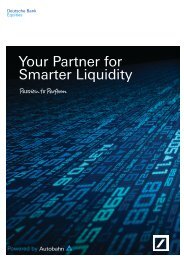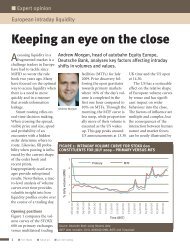FTSE Global Markets - Autobahn - Deutsche Bank
FTSE Global Markets - Autobahn - Deutsche Bank
FTSE Global Markets - Autobahn - Deutsche Bank
Create successful ePaper yourself
Turn your PDF publications into a flip-book with our unique Google optimized e-Paper software.
US TRADING ROUNDTABLE<br />
LESSONS FROM MARKET CHANGE:<br />
WHO WINS, WHO LOSES IN THE<br />
NEW TRADING PARADIGM?<br />
Photograph © <strong>FTSE</strong> <strong>Global</strong> <strong>Markets</strong>, supplied July 2012.<br />
Attendees<br />
(From left to right)<br />
CURT ENGLER, quant and automated trading, JPMorgan Asset Management<br />
JOSE MARQUES, global head of electronic equity trading, <strong>Deutsche</strong> <strong>Bank</strong><br />
ROB KAROFSKY, global head of trading at Alliance Bernstein<br />
MIRANDA MIZEN, head of equities research, TABB group<br />
FRANCESCA CARNEVALE, director, <strong>FTSE</strong> <strong>Global</strong> <strong>Markets</strong><br />
F T S E G L O B A L M A R K E T S • J U LY / A U G U S T 2 0 1 2<br />
Supported by:<br />
55
56<br />
TRADING ROUNDTABLE<br />
WORKING IN A NEW PARADIGM &<br />
HOW BEST TO FIND LIQUIDITY<br />
JOSE MARQUES, GLOBAL HEAD OF ELECTRONIC<br />
EQUITY TRADING, DEUTSCHE BANK: The markets<br />
today are as challenging as I’ve ever seen in my career, not just<br />
from a pure execution and quality of execution perspective, but<br />
in really understanding the liquidity landscape and how to<br />
navigate it in a way that allows my clients to really exploit the<br />
limited liquidity resources that are out there, and how as a<br />
broker we can create value for them in that process.<br />
CURT ENGLER, HEAD OF QUANTITATIVE AND<br />
AUTOMATED TRADING, JPMORGAN ASSET MAN-<br />
AGEMENT: We are focused on optimising the trading<br />
process. That includes understanding the portfolio manager’s<br />
process and researching the trade data which allows us to<br />
automate a significant amount of our flow. That also means we<br />
have to monitor both the macro and micro segments of the<br />
market, to better understand what is going on with volume<br />
and volatility. Many of our automated strategies are in house<br />
algorithms that we can tune to specific portfolio managers as<br />
well as market conditions. For us business is now about having<br />
to be on top of the portfolio manager’s process, the characteristics<br />
of the orders, and the market conditions.<br />
ROB KAROFSKY, GLOBAL HEAD OF TRADING AT<br />
ALLIANCE BERNSTEIN: There is also another element in<br />
play: that is, the trader is getting closer to the investment<br />
decision-making process in a world where liquidity has<br />
become a scarce resource. The ability to react quickly is<br />
dependent upon understanding which way your portfolio<br />
manager is going to zig and which they’re going to zag. It is<br />
about taking the trading and execution business directly<br />
into the investment process; and this trend is relevant and<br />
essential because of the difficulty of finding liquidity. In a<br />
highly volatile and highly correlated environment there’s a<br />
tremendous amount of alpha that can be extracted through<br />
the trading desk.<br />
We are in a new paradigm and I don’t think that it is<br />
necessarily cyclical. Certainly, it is unlikely that we will<br />
revert back to the 9bn shares a day that we used to trade<br />
in the United States. In part, this is because everything<br />
we’re living through now is a by-product of the two crises<br />
that have occurred during the last three or four years. In<br />
part, it is a function of a trend where equities as an investible<br />
asset class are out of favour. Year to date, we have<br />
seen in excess of $70bn in outflows and it is a continuing<br />
theme and this money is moving into fixed income. When<br />
you have global monetary authorities telling you that rates<br />
will be low through 2014, it’s an issue that will keep us out<br />
of equilibrium for some period of time, whether it’s artificial<br />
or not. Moreover, it is destructive to the liquidity in the<br />
equity markets. For that reason, I don’t believe that<br />
liquidity in the marketplace (and hence volumes) will pick<br />
up until money begins to flow back into the equity asset<br />
class. That will only happen when rates, particularly short<br />
rates, begin to rise and force people out of fixed income<br />
and into equities.<br />
MIRANDA MIZEN, HEAD OF EQUITIES RESEARCH,<br />
TABB GROUP: Our role is to look across the industry as<br />
objective observers. We spend an enormous amount of time<br />
talking to the market practitioners that make up the marketplace.<br />
We see a huge amount of changes are both currently<br />
visible and some that may happen that will change the<br />
makeup of the market and liquidity patterns. Regulation<br />
and technology have both become equally challengers and<br />
facilitators in the market and are both developing at a very<br />
fast pace but the hunt for liquidity is not getting any easier.<br />
ROB KAROFSKY: One more thing: if you look over the last<br />
several years, the absence of retail in equity trading has significantly<br />
exacerbated the situation. If the retail component<br />
is gone and if you’re talking about liquidity between one<br />
large asset manager selling and another buying, it is like<br />
ships passing in the night. You then are dependent upon<br />
finding that other large institutional holder on the other side<br />
of the trade if you will; it makes the problem of sourcing<br />
liquidity that much more complicated. So once again I say,<br />
we are living in a new paradigm and this paradigm will<br />
remain for the next couple of years, at least.<br />
JOSE MARQUES: There has been a lot of press over the last<br />
couple of years about the role of liquidity providers in the<br />
market. There used to be specialists who were clearly identifiable.<br />
You could walk down to the exchange and if you didn’t<br />
like the other side of a transaction, you could challenge the<br />
person directly. Nowadays, liquidity has become much more<br />
anonymous. When we talk about liquidity, it really is about the<br />
ability to convert cash into securities and securities back into<br />
cash and how quickly and how fungible that process is.<br />
In that regard, the role of the liquidity provider is greatly misunderstood<br />
in today’s marketplace. When you look closely at<br />
the dynamics of what’s going on, a buy side to buy side natural<br />
match happens with such small frequency that it’s almost de<br />
minimus. If there really was a buy side to buy side relationship<br />
then platforms such as Liquidnet would have huge market<br />
share. In reality though, this does not happen, simply because<br />
if one buy side institution wants to sell, it doesn’t automatically<br />
mean that there is a buy side institution that is willing to buy.<br />
Instead there is an entire ecosystem of liquidity providers<br />
that have evolved in the marketplace and they collect a toll<br />
for their services. Having continuous liquidity has never<br />
been free and it is certainly not free today. What you see on<br />
the shortest horizons are the high frequency market makers,<br />
and they are intermediating those trades a couple hundred<br />
shares at a time and taking a tiny slice out of those trades.<br />
Next on the horizon are the statistical arbitrage traders, who<br />
are in fact intermediating the high frequency guys and they’ll<br />
take inventory and keep it in mid-air for anywhere between<br />
a few minutes to a few days. Then there are the slightly<br />
longer horizon players, which include the hedge fund<br />
community, which in turn will keep inventory in suspended<br />
animation until a long-term player on the other side shows<br />
up who perhaps wants to do the whole process in reverse.<br />
It is this ecosystem that provides the liquidity and ultimately<br />
intermediates a long-term buyer and a long-term<br />
seller, which can show up hours, days, weeks, even months<br />
J U LY / A U G U S T 2 0 1 2 • F T S E G L O B A L M A R K E T S
Jose Marques, global head of electronic equity trading, <strong>Deutsche</strong> <strong>Bank</strong>.<br />
Photograph © <strong>FTSE</strong> <strong>Global</strong> <strong>Markets</strong>, supplied July 2012.<br />
apart in time. Certainly, from a regulatory market structure<br />
perspective, we need to understand how this works. We<br />
need to know what the cost of this liquidity really is and<br />
what structures ultimately make the markets more efficient<br />
and maximise the amount of instantaneous liquidity<br />
available for everyone. One interesting point is that the very<br />
richness of equities as an asset class that drives the diversity<br />
the ecosystem which in turn delivers the tremendous<br />
amount of continuous liquidity we see.<br />
CURT ENGLER: We have had such an interesting period of<br />
a rather volatile macro environment; when volatility comes<br />
down, liquidity is going to come down. At the same time, we<br />
have had such deleveraging out of a lot of strategies that<br />
were called more intermediate term—as Jose explained—<br />
that everyone used to be leveraged a lot higher than they are,<br />
particularly as banks are also lowering their leverage ratios.<br />
Whether this really is or is not a new paradigm, I cannot say.<br />
I don’t know what the headlines are going to be tomorrow<br />
that might completely change this set up.<br />
ROB KAROFSKY: This is an interesting point, that volume<br />
and volatility are linked. Volatility goes up, and volumes<br />
obviously increase and as we have seen, a larger percentage<br />
of that increase is going into ETFs and not individual stocks.<br />
When (and if) we do get into a better paradigm where<br />
volumes pick up, we need to see that link between volumes<br />
and volatility break. Would you agree? We need to achieve<br />
healthy volumes without market volatility.<br />
CURT ENGLER: You would have a lot of happier people in<br />
the industry rather than the other way around. It is certainly<br />
better than the alternative where volatility spikes and<br />
volumes remain low; that’s a double whammy.<br />
ROB KAROFSKY: Actually, we do have that.<br />
CURT ENGLER: Liquidity can still be fleeting in the shortterm<br />
if you are too much of a liquidity demander and that’s<br />
going to lead to higher costs. If all else is equal, volumes stay<br />
the same and volatility goes up, leading to higher costs. So,<br />
if we could ever get that sweet spot where volatility stays relatively<br />
constant and volumes start picking up, then correspondingly<br />
trading costs should come down all else being<br />
equal and I would welcome that. The question of course<br />
hangs around how we make that happen.<br />
ROB KAROFSKY: As I look at the world, I see would look<br />
for the signal that assets (or money) are flowing into equity<br />
assets and equity risk premiums are coming down, which<br />
correlates with your comment about volatility. People will<br />
have to feel much more comfortable in the equity space<br />
and once that happens you can have volumes without the<br />
volatility. We would, in that instance, turn the corner.<br />
JOSE MARQUES: Another way of looking at this is correlation.<br />
In the current high correlation environment you’re seeing<br />
F T S E G L O B A L M A R K E T S • J U LY / A U G U S T 2 0 1 2<br />
people coming into the market demanding macro equity<br />
exposure. But they come in one day and they leave the next day<br />
and, at the same time, you’re seeing a lot less of a stock<br />
selection process happening. So you get exactly what you see.<br />
MIRANDA MIZEN: Last year the combination of higher<br />
volatility and the higher volume also resulted in a higher<br />
percentage of high frequency trading. If we have lower level<br />
of volatility and if we see assets coming back into the market,<br />
we should see the participation rates of some of the participants<br />
in the market change proportionally.<br />
ROB KAROFSKY: Well, it increases the odds in a lower<br />
volatility environment of two ships hitting each other when<br />
they pass through at night.<br />
JOSE MARQUES: The data there is pretty straightforward.<br />
About 30% of liquidity is found within broker pools in general<br />
or dark venues overall. You see that in the TRF volumes for the<br />
US. The rest is found in the broad markets. The underlying<br />
question there seems to be: do we need 48 different dark pools<br />
and 17-plus lit venues? Clearly not. On the other hand, the<br />
technology has gotten cheap enough and robust enough that<br />
connectivity between venues is not the hurdle that it used to<br />
be and in some sense, it has gotten cheaper.<br />
One of the underlying benefits of our highly decentralised<br />
marketplace is a tremendous amount of robustness in our<br />
markets. It used to be front page news whenever NYSE had<br />
a system outage and stocks could not trade for a whole<br />
afternoon. When was the last time you saw a headline like<br />
that, aside from May 6th 2010? There have been real benefits<br />
to the fragmented structure, but like anything you can overdo<br />
it and there is a selection process underway. Even so, the costs<br />
are not outrageous; at least not for most participants.<br />
MARKET EVOLUTION: HOW FAST &<br />
DEEP IS THE RATE OF CHANGE?<br />
FRANCESCA CARNEVALE: Miranda, has TABB Group<br />
undertaken any research that looks at how the overall<br />
market structure will look in a few years time? As Rob highlights<br />
there is a paradigm shift in play. Surely, that must test<br />
existing structures and institutions and firms to the limit.<br />
How might it play out over the long term?<br />
MIRANDA MIZEN: We have undertaken a number of big<br />
studies around this theme, talking to long only asset<br />
managers and hedge funds, both here and in Europe. In<br />
January this year, we talked to 51 hedge funds and found a<br />
perhaps surprising level of optimism in the market. Many<br />
were thankful last year was over as they had found that<br />
volatility around volumes was extremely testing. There was<br />
a certain relief they had managed to survive a brutal trading<br />
environment and ventured that (overall) this year would be<br />
better, that early election fever would reinvigorate the market<br />
and that commission wallets would increase. However, that<br />
was early in the year and as the months have passed, that<br />
optimism has not played out.<br />
There are a number of trends coming in play as a function<br />
of lower trading volume. Low commission wallets mean<br />
there is not always enough to go round and broker lists are<br />
57
58<br />
TRADING ROUNDTABLE<br />
being scrutinized, especially as you look down the length of<br />
the tail. There is not a major change in commission concentration<br />
levels at the top. But brokers who are sitting on lists<br />
and haven’t seen order flow from their client for a year are<br />
very vulnerable and in some cases tails are being chopped<br />
quite aggressively.<br />
Asset managers are also re-examining some of the tools<br />
they’re using and how they want to access the market. If it’s<br />
obvious where liquidity is concentrating, the decision is how<br />
to interact with that liquidity. But especially in the dark,<br />
liquidity may be so scattered it’s hard to know if there’s<br />
another ship out there, let alone if it’s passing you in the dark.<br />
So there’s a constant demand for better tools such as those<br />
that combine block trading with algorithms and that can<br />
interact with the different types of liquidity, and duck and dive<br />
electronically in the market like the traders do. But tools<br />
aside, low volume markets and shifting liquidity patterns<br />
due to both trading styles and investment decisions require<br />
a re-think with regard to how to approach the market.<br />
We have this paradigm shift and although we all hope<br />
volumes will rise again, it doesn’t look likely in the short term,<br />
particularly in Europe where the outlook remains poor and the<br />
regulatory environment is undergoing a major upheaval.<br />
FRANCESCA CARNEVALE: Jose what is the role of the<br />
sell side in easing everyone’s pain?<br />
JOSE MARQUES: In today’s environment, the role between<br />
a broker and the buy side has turned back to the fundamental<br />
value propositions brokers traditionally have offered. In<br />
other words, if you ask: what is the role of the broker in the<br />
marketplace? It is to source and aggregate liquidity for the<br />
buy side and provide it to them in a cost effective way. By cost<br />
effective, I am not talking about commission rates; that’s<br />
really the total impact of trading. A good broker is going to<br />
deliver execution, and not leak information; a good broker is<br />
going to be able to provide you liquidity in whatever it is<br />
you’re looking for in the cheapest way possible. Then if he<br />
does it well, you’re going to reward him.<br />
Over the last couple of years, there’s been a lot of angst<br />
around the new electronic market structure and the problems<br />
this structure has created for participants that haven’t yet<br />
invested in the latest and fastest technology, whether that be<br />
co-location, or the whole techno-parlance of the new world.<br />
Ultimately, we have a pretty simple message to these folks,<br />
which is: if you don’t like your executions, get another broker.<br />
At the end of the day, the broker’s role is to provide technology<br />
and smart, intelligent execution, to control information<br />
and give clients a buffer on those hard to trade trades. If your<br />
broker is not effective, you must find someone who will<br />
move your business accordingly.<br />
CURT ENGLER: There’s a lot in this conversation to synthesise.<br />
I guess I’ll start by piggy-backing on two of the<br />
comments Jose made about the broker’s role and (as well)<br />
the trader’s job to understand the investment process better.<br />
Both those comments were spot on. Certainly, as markets<br />
evolve the buy side trader will increasingly be tasked with<br />
being more strategic in the whole investment process. In any<br />
case, it is incumbent on the buy side trader to better under-<br />
Curt Engler, quant and automated trading, JPMorgan Asset<br />
Management. Photograph © <strong>FTSE</strong> <strong>Global</strong> <strong>Markets</strong>, supplied July 2012.<br />
stand the importance of the overall investment strategy that<br />
determines his trades as well as to be more proactive with<br />
regard to sourcing liquidity so that, if one of those ships does<br />
show up, the buy side trade should to be able to filter that<br />
trade in a way that is better for the portfolio manager.<br />
On the electronic side, given that we make the effort to<br />
better understand the portfolio manager’s process—whether<br />
it is what factors they use for stock selection, or their portfolio<br />
construction criteria—and understanding that process to<br />
the point where the broker’s role is going to evolve further.<br />
I actually think the broker’s role will become more difficult<br />
and complex in future; particularly as technology is now one<br />
more level of disintermediation of the sell side to the point<br />
where we can now make all of our own order placements,<br />
rather than just placing it one scheduled algorithm and<br />
work on the basis of the anticipated outcome of that.<br />
MARKET FRAGMENTATION: GET<br />
OVER IT OR UNDER IT?<br />
JOSE MARQUES: Execution and portfolio implementation<br />
costs have come down over the last ten years. Over<br />
the last six months, they’ve probably bottomed out and<br />
maybe ticked up a little bit because of t`he dramatic fall off<br />
in overall market volumes and liquidity. However, market<br />
structure changes have driven a great deal of that drop in<br />
terms of real trade implementation costs with tangible<br />
benefits to investors.<br />
FRANCESCA CARNEVALE: Hasn’t there been an<br />
attendant cost in terms of connectivity, technology, investment<br />
in new processes and linkages with brokers and<br />
trading venues?<br />
JOSE MARQUES: Collectively the sell side spends<br />
hundreds of millions of dollars to develop and maintain its<br />
technology, for sure.<br />
ROB KAROFSKY: As the world has become far more<br />
reliant and dependent on technology, both sides (and it is a<br />
relative spend) have had to spend on technology and<br />
become aware of measured tools and things like that. So that<br />
the explicit costs that Jose mentioned have been coming<br />
down and perhaps bottoming is true. Also, the costs of<br />
being able to navigate the 40-plus dark venues and 17 or so<br />
lit exchanges has also been an offsetting cost.<br />
JOSE MARQUES: Yes, costs elsewhere in the system have<br />
also emerged. TV cameras used to pan around the heavily<br />
populated floor of the New York Stock Exchange, where in<br />
the mid-1990s you could barely walk through the crowd. It’s<br />
a very different picture today and that is the very real impact<br />
technology has had. Of course, this has occurred at all levels<br />
through the markets and in the trading process. We used to<br />
J U LY / A U G U S T 2 0 1 2 • F T S E G L O B A L M A R K E T S
have tens of thousands of people to clear trades. As an<br />
industry, those numbers have come down. There are efficiencies<br />
that have been extracted, even though the technology<br />
costs and people resourcing around technology have gone<br />
up considerably.<br />
WHERE DO YOU FIND ADDED<br />
VALUE AS MARKETS CHANGE?<br />
MIRANDA MIZEN: A major area of differentiation that is<br />
being highlighted over the last six to twelve months is<br />
coverage. Take algorithms, the most commoditised area of<br />
trading. You often hear the buy side grumble there’s little real<br />
difference between many of them. In fact there is, both in<br />
terms of the algorithmic environment and liquidity accessed<br />
as well as in the surrounding services. It isn’t necessarily<br />
someone coming with a new algorithm that’s really going to<br />
make the difference; it may be the coverage person stopping<br />
by, taking off his jacket, sitting down with the client and<br />
talking about how they access the markets and talking<br />
through how they trade their orders, the kinds of algorithms<br />
they need and are comfortable using, how individual algorithms<br />
work with certain market conditions. Increasingly,<br />
coverage combines both elements of high touch and low<br />
touch services.<br />
A major factor is trust, because there’s no way in a highly<br />
volatile, fast-moving market that someone is going to use an<br />
algorithm if he doesn’t know how it performs and exactly<br />
what to expect. Partly this is a function of understanding<br />
both the market dynamics and the technology and having<br />
transaction cost analysis tools, but equally, there is also a<br />
level of human interaction, in terms of providing the<br />
knowledge to use those tools very efficiently. It’s the same on<br />
the high touch side; you have to be able to trust the person<br />
at the other end of the telephone if you’re doing a trade.<br />
The buy side is demanding greater insight into how the algorithms<br />
are working. Not everybody wants to look under<br />
the hood and know where the fan belt is, but in terms of<br />
order placement logic that Rob mentioned earlier, if the<br />
order is being exposed in the dark, where is it being exposed<br />
and to whom? In other words, I want to know where it<br />
traded, but I also want to know where it is going and what<br />
level of exposure goes with it. Who am I trading with and<br />
what is the quality of liquidity at the other end of the order<br />
that may help or not help my order flow? This transparency<br />
is partly coverage, partly product. Ultimately though, they are<br />
two halves of the same whole.<br />
CURT ENGLER: If the buy side is going to make the effort<br />
to understand what the portfolio manager’s process is (and<br />
that the technology is available) we are doing our fiduciary<br />
role to own the order execution process as well. We’re the<br />
ones putting the fixed tags in place, because we want this<br />
many shares placed at this location for this amount of time,<br />
for example. In this regard, the buy side has been the biggest<br />
winner on the transparency front to actually understand<br />
that logic as well as then mine any resulting analytical data<br />
for relevant analysis of orders. People may or may not want<br />
F T S E G L O B A L M A R K E T S • J U LY / A U G U S T 2 0 1 2<br />
to get into that minutia, but once you do, you learn from how<br />
orders are placed at various venues, and where the margins<br />
are made; understanding that entire process is now integral<br />
to doing our job well.<br />
FRANCESCA CARNEVALE: Is that typical though of all<br />
buy side trading desks? Or, is that typical of large buy side<br />
trading desks of the magnitude of your firm, and that of<br />
Rob’s trading desk? It is easy for you, you have resources, and<br />
you are huge asset gatherers, are you not?<br />
CURT ENGLER: You are right, scale certainly plays into it.<br />
We traded $250bn last year and a basis point matters on that<br />
volume. If you’re a smaller asset manager there are likely<br />
different investment strategies and other business considerations<br />
involved. In that instance, the effort required may be<br />
too onerous or high a hurdle. Even so, technology is almost<br />
ubiquitous enough now and in that sense there is a really<br />
low entry level that will allow you to do some of these things<br />
quite easily.<br />
FRANCESCA CARNEVALE: Jose, in this environment and<br />
with that minute detail required, knowing your client very well<br />
indeed is vital to a successful business strategy, isn’t it?<br />
JOSE MARQUES: Absolutely, knowing your client as well<br />
as every detail of their trading processes and trading technology<br />
is essential. As Curt acknowledged, access to modern<br />
trading technology is very democratic, even for small buy<br />
side firms or even retail participants, due to the massive investments<br />
made by the sell side. The key is helping clients<br />
apply the appropriate technologies to their specific trading<br />
problems. It’s not all about speed either. Some of the most<br />
important technologies are all about quantitative processes,<br />
down to the microstructure level, involving how you place<br />
trades, how you read that order book, which venues you go<br />
to and when, and understanding the intention behind that<br />
order when it was sent.<br />
Moving up the value chain, one of the things that both<br />
Curt’s and Rob’s firms do extremely well is understand the<br />
alpha of the portfolio manager and how to modulate trading<br />
to maximize alpha capture. These are things that the sell side<br />
can absolutely provide for all clients and do so by modulating<br />
the behaviour of algorithms based on who’s trading on<br />
the other side and the portfolio manager’s intentions. This is<br />
becoming a very important part of the business because<br />
capturing a few extra mills here and there adds up to percentage<br />
points of incremental returns.<br />
FRANCESCA CARNEVALE: Rob, there’s probably not<br />
much any sell side trader can teach you. So where do you<br />
look for value-add from your sell side provider?<br />
ROB KAROFSKY: Actually, it is complicated navigating the<br />
marketplace. Both Curt and Jose mentioned basis point<br />
matters on a lot of notional trade and that’s absolutely true.<br />
It is how you capture that basis point. Plus, to me that’s the<br />
interesting part. It is not just being a liquidity provider versus<br />
taking liquidity when you’re executing electronically. Where<br />
the sell side truly helps us is in understanding when to<br />
trade with more urgency and understanding when to trade<br />
more slowly. It is taking advantage of liquidity when it comes<br />
to your doorstep and trying to understand where the alpha<br />
59
60<br />
TRADING ROUNDTABLE<br />
is embedded in your order flow if by definition if it is a<br />
value order and in that instance you should trade more<br />
slowly. It is about helping us understand the subtleties and<br />
complexion of the market.<br />
FRANCESCA CARNEVALE: Is that a conversation that<br />
happens before the trade or in real time?<br />
ROB KAROFSKY: It happens in real time and it is ongoing<br />
and it speaks directly to an initiative that many firms<br />
on the sell side are taking where they’re trying to combine<br />
both the electronic and high touch points and deliver<br />
something to clients that hasn’t necessarily been delivered<br />
up to this point. Now, you could argue that this has<br />
happened through daily dialogue in the past. However,<br />
there has been a sea-change; there is now a more<br />
concerted effort by the sell side to be part and parcel of the<br />
process. I am working slowly, trying to have minimal<br />
impact in a particular situation, but if something larger<br />
comes along, I am interested. It is about effectively<br />
combining those different approaches that people are attempting<br />
to achieve now.<br />
FRANCESCA CARNEVALE: Can you measure the<br />
efficacy of this approach in numerical terms?<br />
ROB KAROFSKY: It is difficult to capture 100% of the<br />
dialogue, the relationship that you have on a daily basis, but<br />
it shows up in your performance and we’re constantly evaluating<br />
how we’re doing. We evaluate it every day. And we<br />
can directly attribute it to brokers that help us achieve the<br />
numbers, whether it is through their trading pipes or<br />
whether it is through a piece of liquidity that comes through<br />
their high touch area.<br />
JOSE MARQUES: At the end of the day, realised portfolio<br />
performance matters. From the moment that a portfolio<br />
manager decides he wants to buy or sell a security, at that<br />
instant prevailing market prices are the most relevant<br />
benchmark. Often arrival price, the prevailing market price<br />
when the order is received by the sell side desk is used as a<br />
proxy. When you look at the newest and most creative ideas<br />
we have implemented, they are around creating opportunistic<br />
liquidity-seeking algorithms that really go after alpha<br />
directly and minimizing slippage to arrival price. When the<br />
liquidity is there at an excellent price, clients take all they can,<br />
and when it is not there, they fade the trade and become<br />
patient. Doing that effectively is important.<br />
Now that’s what we do at the end of the value chain, but<br />
there is also an important piece in the middle of the value<br />
chain - between the portfolio manager and the sell side - and<br />
that’s the role of the buy side trader to finesse. We don’t have<br />
complete transparency as to the alpha of an individual<br />
portfolio manager. We have some if it is provided to us, but we<br />
can’t pick up the phone and call the portfolio manager and ask<br />
him: do you want me to be more urgent with this order?<br />
That’s the role of the buy side trader who is to understand his<br />
portfolio managers and what their liquidity needs really are.<br />
I would say it is when all three parties are working<br />
together on this value chain that delivers the best outcome.<br />
A portfolio manager has to be sensitive to his own process<br />
and know when he should be aggressive and communicate<br />
that to his desk, and then the buy side desk can give the appropriate<br />
signalling to their sell side counterparts. The<br />
process works in reverse too. If you look at a portfolio optimisation<br />
process, there are some implicit costs that go into<br />
doing the optimisation. If all of the sudden I can offer a big<br />
chunk of liquidity at a very cheap cost, the portfolio manager<br />
might look at that and say: yes, that’s attractive if I can get<br />
it on the cheap. Otherwise, he might not have done that<br />
marginal trade. So, pushing that information back is very<br />
important too. That speaks to the hybrid model Rob was<br />
talking about, where we combine the smarts of the electronic<br />
world with the sensitivity of the high touch world where we<br />
really know the client; then we will be able to push that<br />
alpha back the other way.<br />
BROADENING THE SKILL SET:<br />
ASSETS OTHER THAN EQUITIES<br />
FRANCESCA CARNEVALE: All this understanding is<br />
well and good. However, there are big macro forces in play<br />
right now. As buy side trading desks, you’re at the forefront<br />
really of the movement out of equities and into fixed income.<br />
How, in turn, are these changes in asset allocation changing<br />
the way that the buy side trading desk operates?<br />
CURT ENGLER: Our desk definitely has a broader skill set<br />
now than before. Historically I guess everybody would’ve<br />
had experience on the single stock side, whereas now we<br />
have two quantitative analysts that are on the desk full-time<br />
now that are the ones who are helping craft the trading<br />
strategies and fine tuning the strategy given the market<br />
dynamics. Along the lines of having people who can speak<br />
the language of the portfolio manager, we have three (CFAs)<br />
involved too, all the while still having very experienced<br />
traders we have hired either from buy side or the sell side on<br />
the desk. However, I would say we have broadened the skill<br />
sets on the desk considerably in response to the market<br />
rather than any sort of shift in what asset class is in favour<br />
or not So having that mix of those different and differentiated<br />
skill sets has been the direction we have taken.<br />
ROB KAROFSKY: I’d say two things. One based on what<br />
I initially said about being in a new paradigm, there’s been<br />
a shift, from the sell side to the buy side in terms of understanding<br />
how to price assets better and how to source<br />
liquidity. We’re definitely seeing that shift. It is a scarce good,<br />
if you will, and the onus is on us to develop expertise in that<br />
area. So, we have certainly moved in that direction and what<br />
that means is staffing the desk appropriately with people<br />
that have that type of experience.<br />
The second thing in terms of dealing with the overall environment<br />
as far as asset flows, that we absolute need to<br />
scale our desks appropriately given the global volumes that<br />
we have experienced and that we probably will experience.<br />
That’s a similar exercise that’s happening on the sell side as<br />
well. We have seen a lot of capacity come out and my guess<br />
is we’ll continue to see more capacity come out.<br />
As far as expertise across asset classes toes, the worlds are<br />
correlated, more so than they’ve ever been. If you’re trading<br />
J U LY / A U G U S T 2 0 1 2 • F T S E G L O B A L M A R K E T S
Rob Karofsky, global head of trading at Alliance Bernstein. Photograph<br />
© <strong>FTSE</strong> <strong>Global</strong> <strong>Markets</strong>, supplied July 2012.<br />
equities and you don’t have that vital understanding of how<br />
credit markets will impact equities, you’re missing an<br />
important step. Therefore, if the world is going to be more<br />
correlated, you need to have an understanding of how commodities<br />
and credit and things of that nature are going to<br />
impact idiosyncratic moves in stocks.<br />
One of the things that we have done is we have moved all<br />
of our trading capabilities onto one floor to help enhance<br />
that connectivity. It is important than having one person<br />
trade multiple thing. Given our size, it is not realistic. With<br />
smaller hedge funds or smaller asset managers, it is more<br />
that they aren’t dealing with as many transactions so perhaps<br />
it is more achievable, but I still think, at the larger institutions,<br />
that you need a certain amount of specialisation in<br />
order to effectively executive and more importantly become<br />
embedded in the investment process.<br />
FRANCESCA CARNEVALE: How much analytical work,<br />
Miranda, is being or has been done on the long-term impact<br />
of these changes in the way that buy side trading operations<br />
are structured and the increased skill sets that are being<br />
imported into the buy side? What ultimately might this<br />
mean for the definition of sell side services?<br />
MIRANDA MIZEN: As an average over the last couple of<br />
years on the buy side, and taking in the biggest and the<br />
smallest firms into account, we haven’t seen a huge amount<br />
of change in terms of sheer numbers of people per desk. But<br />
obviously the markets are a lot more complex so each person<br />
is doing a lot more. The point Rob made about having to worry<br />
about credit risk as well as credit markets is true. There is a far<br />
greater need for and awareness of the influence of other asset<br />
classes on equity trading or geographical influences. May the<br />
6th Flash Crash was a classic example: one minute the events<br />
in Greece were being played out on the television, the next<br />
minute they were unravelling on our own trading doorstep.<br />
To stay on top of so many different things going on has led<br />
to investment in seamless toolsets on the desktop, reducing<br />
any manual handoffs in the execution chain and expanding<br />
and improving the capabilities of execution management<br />
systems on the desk. There will never be a one size fits all<br />
solution going forward, that’s for sure. There needs to be flexibility<br />
and there are very few systems that do absolutely<br />
everything extremely well that everyone needs. Nonetheless,<br />
there is a very high attention being paid to how the tools<br />
interact, both from the execution and into the order management<br />
systems and back into all the way back up to portfolio<br />
managers. Some of that is being driven by regulation and the<br />
need to have new compliance procedures, reduce risk, add<br />
new reporting standards and make sure that there aren’t<br />
manual processes and file transfers that introduce risk<br />
because it’s a break in the chain.<br />
F T S E G L O B A L M A R K E T S • J U LY / A U G U S T 2 0 1 2<br />
While the trading desk size hasn’t changed significantly,<br />
the scope of what some buy side firms trade has. A small<br />
hedge fund for example may have a trading desk of two<br />
people; trading the US markets is one thing, but it is a<br />
different story when branching out to trade markets on the<br />
other side of the world in search of alpha. While larger<br />
houses have local offices and have the choice of building<br />
their own technology, most rely on their brokers for the<br />
combination of access, information and execution tools.<br />
JOSE MARQUES: A few years ago there was a lot of talk<br />
about multi asset class convergence - where in the future<br />
you’d stack every asset known to mankind, working with<br />
geniuses who would be able to trade everything all the<br />
time and never sleep. That’s simply not realistic in the real<br />
world. The role of the specialist in asset classes isn’t going<br />
away. There are a lot of idiosyncrasies, market microstructure<br />
issues, regulatory issues that vary dramatically across<br />
the asset classes. So what we’re doing and what you’ll see<br />
broadly is that the specialisation function, both on the buy<br />
side and the sell side, will remain and what is happening is<br />
a convergence of tools and trading techniques across<br />
different asset classes even as regulators drive for uniformity<br />
of market structures. For instance, now algorithms are<br />
applied to FX trades. Liquidity seeking algorithms that<br />
have been developed in equities are certainly directly applicable<br />
to other asset classes that are traded on exchanges or<br />
exchange-like structures. Moreover, it allows them also to<br />
find that liquidity or assess its relative value and then decide<br />
whether they take it or not. In that regard, you’re seeing a<br />
lot more sharing of tools and techniques and understanding.<br />
We also able to link together some of the more esoteric<br />
bits of what happens in other markets and how they affect<br />
equities and vice versa. Therefore, I would say that there is<br />
definitely convergence of understanding underway; but, at<br />
the end of the day, there still has to be specialisation, which<br />
will remain for quite some time.<br />
CHANGING ECONOMICS in THE<br />
BUY SIDE/SELL SIDE RELATIONSHIP<br />
FRANCESCA CARNEVALE: Is there a new understanding<br />
of the need to pay for consumption and resources in such<br />
a complex and changing trading environment?<br />
ROB KAROFSKY: Yes, absolutely and speaking for our<br />
firm, more so than ever. As liquidity is scarce, so are some<br />
sell side resources. I truly believe that we all make money<br />
together in this industry and we all lose money together in<br />
this industry, meaning that obviously there are divergences.<br />
In general though we’re all going through a difficult time and<br />
the sell side will have to do some hard facing of facts in its<br />
efforts to try to figure out an effective business model and,<br />
at the same time, how to scale their operations to provide<br />
and service varying levels of volume and volatility which are<br />
key drivers of revenues. Moreover, as we are about to deal<br />
with massive regulatory change which could at some point<br />
also cut off some key drivers of revenues for the sell side, I<br />
wouldn’t be surprised if we get to a model where the sell side<br />
61
62<br />
TRADING ROUNDTABLE<br />
are demanding some sort of operating margin with their buy<br />
side clients, which is something that we may have to deal<br />
with at some point soon in the future. The days of subsidising<br />
one business for another business are, given current circumstances,<br />
going to be far and few between. We are very<br />
well aware that there’s no free business anymore. We have<br />
bills to pay and we need to make sure that we’re paying the<br />
people. We are very focused on it right now and our list has<br />
shrunk, which if everyone is working in this way, ultimately<br />
has important consequences for the market. I think it is inevitable<br />
that people at the top of the food chain will, overall,<br />
take more business because of these changes.<br />
That being said, we need to be relevant to people that we<br />
believe add value to us and deliver resources that help us<br />
make money, period. Miranda was talking about broker lists<br />
and things like that. Yes, we are becoming very aware about<br />
whom we’re doing business with and why we’re doing<br />
business with them and how we are paying those people. It<br />
is an important initiative that’s going on at our firm and I<br />
would imagine right now that it is an important initiative<br />
going on at every firm.<br />
MIRANDA MIZEN: It is absolutely true that the buy side<br />
needs to know who they’re paying and why they’re paying<br />
them. We have already seen broker lists being curtailed, and<br />
similarly brokers have to make decisions about the client<br />
segments they want to service. This looks set to continue in<br />
the current environment, and some of those consequences<br />
will be positive. Do we need, for instance, so many dark<br />
pools? Well, if we don’t and liquidity continues to form in only<br />
some of them, then others might naturally fall by the wayside.<br />
Natural competition might solve some issues of fragmentation<br />
and cost. So many people are electronically connected.<br />
Those connections cost money even if it is not in a pure<br />
payment form. Even so, they still accrue maintenance costs.<br />
Inevitably then, there is a lot of attention being paid to those<br />
hidden costs of doing business, of just having these connections<br />
and how you deploy your resources within the company,<br />
which then dictates what you’ve got left for some of those<br />
more innovative and discretionary and interesting projects,<br />
other than just trying to meet the next regulatory deadline. So<br />
much more is now visible in a way that it wasn’t five or six<br />
years ago in terms of explicit and implicit costs, in terms of<br />
bundling and unbundling, in terms of the way things are<br />
allocated, who they’re allocated to, why they’re allocated.<br />
CURT ENGLER: Obviously, there are implicit and explicit<br />
costs. Tackling implicit costs will always be a battle. As for<br />
explicit costs, clearly the sell side is under some considerable<br />
pressures, given the backdrop of the market. That said it is<br />
not sustainable to have 100% loss ratios or have the sell side<br />
not earning a return. With that in mind, what’s in store for<br />
the future? It could range anywhere from a cost plus type<br />
model where if we have fixed tags that we know exactly the<br />
cost implication if we’re adding or taking liquidity. That’s a<br />
significant swing in the profitability of execution on the<br />
explicit side. Then again there is the whole range of services<br />
that the sell side provides. It is just determining, accurately,<br />
what is that actually worth? If in practice it was easy to just<br />
Miranda Mizen, head of equities research, TABB group. Photograph ©<br />
<strong>FTSE</strong> <strong>Global</strong> <strong>Markets</strong>, supplied July 2012.<br />
come up with a ledger of the costs involved and the revenue<br />
needed to cover those costs, it would all be simple. Life unfortunately<br />
isn’t that simple. Now there could be a whole<br />
host of other unintended consequences from applying a<br />
cost plus model, but to me it makes sense.<br />
What’s happening in the trading world and in financial<br />
services in general, in this post 2008 period, is really not all<br />
that different from what’s happening in just about every<br />
other industry in our economy; whether it is automobile<br />
manufacturing or airline seats. Technology has been a highly<br />
disruptive influence, margins have collapsed for a lot of<br />
reasons and there is a fundamental restructuring going on<br />
in the marketplace, and it is happening both on the buy side<br />
and sell side. Buy side desks are much smaller and more<br />
efficient than they’ve ever been and the sell side is working<br />
aggressively to become more efficient as well. This is part of<br />
the natural evolution of things and trading desks have to face<br />
this issue and deal with it.<br />
ROB KAROFSKY: The sell side equity business model has<br />
always been inefficient and that’s why they talk about specialisation.<br />
The sell side has layers and layers of specialisation.<br />
If you look at touch points, it is electronic, it is<br />
programme, it is cash, it is derivatives, it is research sales, it<br />
is speciality sales; it is just on and on and on and on. And this<br />
in a business that is 100% about picking up pennies and you<br />
need to do everything to pick up that penny! As Jose<br />
mentioned, this environment could provide the catalyst to<br />
finally change the business model and help evolve it and<br />
move it on to the next level. There’s always been a concern<br />
and I’m guilty as well, of moving ahead of your clients, the<br />
people that are paying you. It has always been a concern. We<br />
may be at a point now where you have to take that risk of<br />
changing your approach and business model in order to<br />
preserve or drive profitability over the longer term. Change<br />
is coming firms that are facing up to that change and<br />
respond to it as Jose describes, will be the winners.<br />
JOSE MARQUES: These changes are gut-wrenching<br />
whenever they happen. As Rob says, there will be clear<br />
winners and losers. But the story is the same in other industries.<br />
They have had to make wholesale changes and they are<br />
now benefitting from those changes. In the 1980s you could<br />
hardly get me to rent an American car, let alone own one.<br />
Now American cars are fantastic; cars coming out of Detroit<br />
are now on par with anything being produced anywhere in<br />
the world. Similarly in our industry, we are now forced to<br />
look hard at what we do and why we do it. What you’ll ultimately<br />
see is a much, much more efficient, better and more<br />
transparent trading environment. Though it may be a few<br />
more years for this play out fully, change is a reality. ■<br />
J U LY / A U G U S T 2 0 1 2 • F T S E G L O B A L M A R K E T S


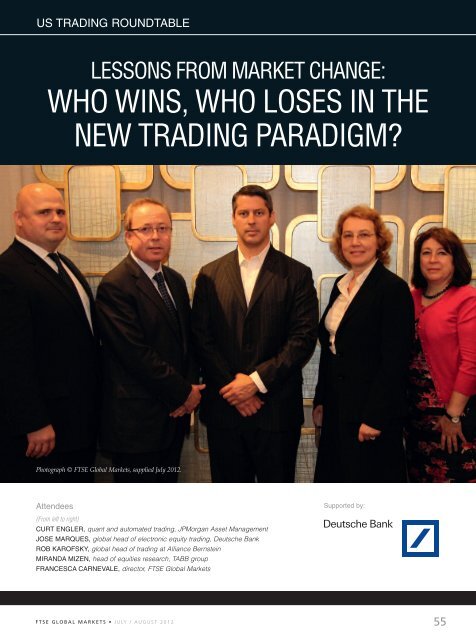
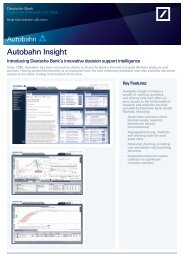



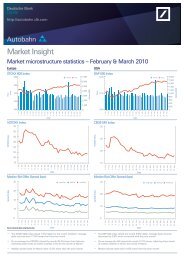
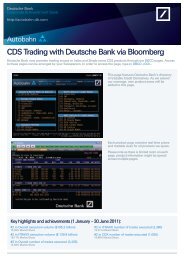
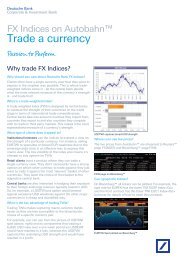
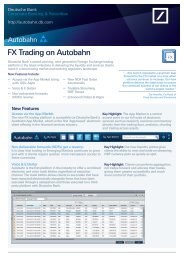
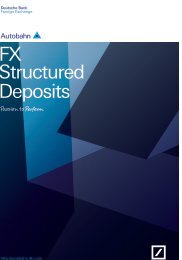
![View [2.12 MB] - Autobahn - Deutsche Bank](https://img.yumpu.com/30956182/1/184x260/view-212-mb-autobahn-deutsche-bank.jpg?quality=85)
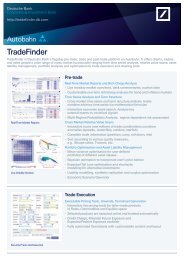
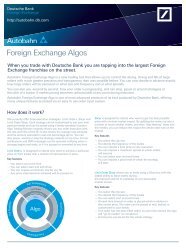
![View [2.71 MB] - Autobahn - Deutsche Bank](https://img.yumpu.com/30327613/1/184x260/view-271-mb-autobahn-deutsche-bank.jpg?quality=85)
